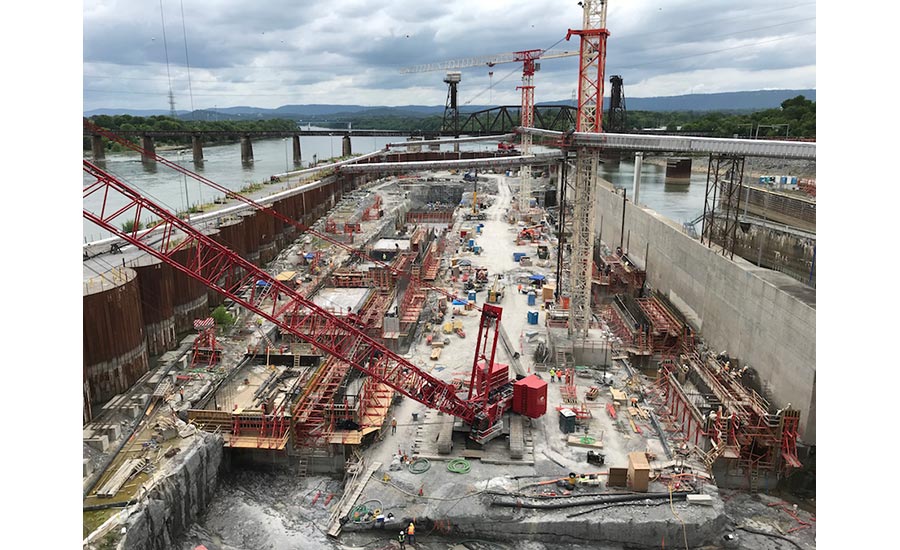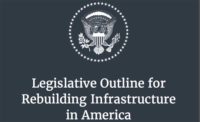House Democrats on June 22 released the detailed legislative text of a measure that would combine highway, transit and rail provisions with funding increases for other infrastructure such as drinking water, wastewater treatment, schools, broadband and housing. It also funds clean energy programs and has other climate change-related provisions.
[View fact sheet on bill here, detailed section-by-section summary here, and 2,309-page text of bill here.]
In a critical addition, the new $1.5-trillion Moving Forward Act includes a menu of options to raise the mammoth amounts of new revenue needed to fully pay for funding increases. Most of those options involve various types of bonds, but the plan also includes a sizable infusion of funds to fortify the weakening Highway Trust Fund.
Democratic leaders are aiming to have a floor vote on the proposal before the July 4 break.
Besides the $494-billion highway-transit-rail section, other highlights of the House Democrats’ package include:
- Airports: $37.5 billion, including $17.5 billion from the general fund for Airport Improvement Program infrastructure grants
- Wastewater treatment: $45 billion, including $40 billion for Clean Water State Revolving Funds
- Broadband: Nearly $100 billion
- Health care: $100 billion for improvements to hospitals, community health centers and research facilities
- School construction: $100 billion
- Army Corps of Engineers civil works projects: $10 billion
- Clean energy, including renewables: $70 billion
- Affordable housing: $100 billion
Officials in those infrastructure sectors welcomed the additional dollars.
Todd Hauptli, the American Association of Airport Executives' chief executive officer, in a statement, welcomed the bill's "significant funding to build the airport infrastructure our country needs."
Kristina Surfus, National Association of Clean Water Agencies managing director for government affairs, said via email that the funding levels for wastewater treatment would reduce the backlog of projects in that sector.
Surfus says that besides the SRF funds, "The House also inclued signficant bumps in grant dollars for sewer overflows, stormwater controls and resiliency, which are critical to address long-term investment needs—and we are pleased to see actual grant dollars being incorporated in addition to financing."
Industry Support
Industry officials also praised the overall scope of the House Democrats’ proposal. Sean O’Neill, senior vice president for government affairs for the Portland Cement Association, said in an interview, “Overall, we’re pleased that House Democrats recognized the fact that we need to invest more money in all sorts of infrastructure.”
Stephen E. Sandherr, CEO for the Associated General Contractors of America, said in a statement, “These broad investments will support demand across many different construction sectors, helping to offset expected declines in private-sector activity.”
The expansive legislation differs greatly from the narrower infrastructure approach taken in the Senate, where a $287-billion highway authorization and two water infrastructure measures, totaling $19.5 billion, have cleared committee.
Dave Bauer, CEO of the American Road & Transportation Builders Association, said in an interview that the House package “is a strategic decision to lump surface transportation reauthorization, which is scheduled for action in approximately a hundred days, with a number of other items that don’t have a deadline.”
Another key difference is that the House package is overwhelmingly a Democrats-only product. The Senate committee bills, on the other hand, were strongly bipartisan and were approved unanimously.
But none of the three Senate committee bills had provisions identifying how to raise the needed revenue. The new measure from House Democrats does.
The revenue-raisers include reviving the Build America Bonds program. Created in 2009, the program used taxable, federally subsidized bonds to provide low-interest financing for infrastructure around the U.S. Before the program expired at the end of 2010, it had produced $180 billion in bonds.
The Democrats’ plan also calls for raising the current cap on the volume of private-activity bonds that can be issued, although the total revenue that would be raised isn’t clear. The House Ways and Means Committee, which oversaw that part of the bill, didn’t immediately respond to ENR’s request for details.
Closing the Highway Trust Fund Gap
The Highway Trust Fund provision is critically important to engineering and construction firms that focus on highway and transit work. The $145.3-billion transfer would close the gap between the trust fund’s current resources and the highway and transit portion of the overall package.
House Transportation and Infrastructure Committee Chairman Peter DeFazio (D-Ore.) had estimated the gap at $138 billion.
The Transportation Committee had slogged through the better part of two days to finish the $494-billion Investing in a New Vision for the Environment and Surface Transportation, or INVEST, in America Act. That legislation, which now is folded into the Moving Forward package, would authorize $319 billion for highways, $105 billion for transit and $60 billion for rail. But it had no revenue provisions.
Bauer says of the new package’s trust fund provision, “It was the missing piece of the puzzle.”
House Democratic leaders are aiming for a floor vote on their mega-bill by the July 4 recess. Because of their party’s majority, approval on the House floor is virtually certain.
But a key question is whether a big package can move any further, given the Democratic stamp on the House measure and the bipartisan nature of the Senate’s transportation and water bills.
NACWA's Surfus says, "We view [the package] as a House marker, but the Senate will want to develop its own infrastructure package with less overall spending."
She says that in the water area, a focused but "very robust" measure is more likely than a trillion-dollar-plus, multi-sector package. "However," Surfus adds, "with some Republicans supporting more infrastructure investment, and given the way the pandemic continues to hinder the economy and jobs, I think there is a good possibility we eventually see a big bigger action on infrastructure stimulus over the course of the year."
“There’s a path to getting a bipartisan package done here,” says O'Neill. “It’s just whether or not the powers-that-be decide to go that route.”
ARTBA’s Bauer says, “Inherently, whether it starts bipartisan or not, it’s going to be a bipartisan outcome—if there is an outcome.”
Story updated on 6/24/2020 with comments from National Association of Clean Water Agencies and American Association of Airport Executives.





Post a comment to this article
Report Abusive Comment